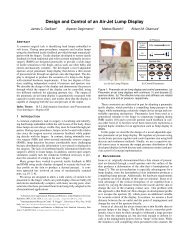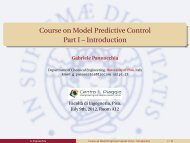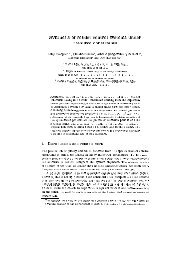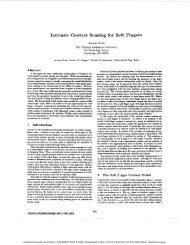Analysis and Design of an Electromagnetic System for ... - IEEE Xplore
Analysis and Design of an Electromagnetic System for ... - IEEE Xplore
Analysis and Design of an Electromagnetic System for ... - IEEE Xplore
- No tags were found...
Create successful ePaper yourself
Turn your PDF publications into a flip-book with our unique Google optimized e-Paper software.
1876 <strong>IEEE</strong> TRANSACTIONS ON MAGNETICS, VOL. 41, NO. 5, MAY 2005<strong>Analysis</strong> <strong><strong>an</strong>d</strong> <strong>Design</strong> <strong>of</strong> <strong>an</strong> <strong>Electromagnetic</strong> <strong>System</strong><strong>for</strong> the Characterization <strong>of</strong> Magneto-RheologicalFluids <strong>for</strong> Haptic InterfacesA. Bicchi 1 , Senior Member, <strong>IEEE</strong>, M. Raugi 2 , R. Rizzo 2 , <strong><strong>an</strong>d</strong> N. Sgambelluri 1Interdepartmental Research Centre “E. Piaggio,” University <strong>of</strong> Pisa, 56100 Pisa, ItalyDepartment <strong>of</strong> Electrical <strong>System</strong>s <strong><strong>an</strong>d</strong> Automation, University <strong>of</strong> Pisa, 56100 Pisa, ItalyIn this paper, the synthesis <strong><strong>an</strong>d</strong> design <strong>of</strong> a new device <strong>for</strong> the energization <strong><strong>an</strong>d</strong> characterization <strong>of</strong> magneto-rheological fluids (MRF)<strong>for</strong> haptic interfaces are presented. Due to the core structure <strong><strong>an</strong>d</strong> feeding conditions, only a three-dimensional numerical <strong>an</strong>alysis provides<strong>an</strong> accurate prediction <strong>of</strong> the electromagnetic qu<strong>an</strong>tities <strong><strong>an</strong>d</strong> the rheological behavior <strong>of</strong> <strong>an</strong> excited specimen. The design constraintsare shown in details <strong><strong>an</strong>d</strong> the results in terms <strong>of</strong> magnetic field inside the fluid <strong><strong>an</strong>d</strong> its spatial resolution are discussed.Index Terms—<strong>Electromagnetic</strong> (EM) device, haptic interfaces, magneto-rheological fluid (MRF).I. INTRODUCTIONIN MANY haptic applications, the ideal device would allowa user to feel virtual objects by freely moving his/her h<strong><strong>an</strong>d</strong>without mech<strong>an</strong>ical constraints. Accordingly, in order to design<strong>an</strong> innovative haptic interface <strong>for</strong> whole-h<strong><strong>an</strong>d</strong> immersive exploration,we consider the possibility <strong>of</strong> using magneto-rheologicalfluids (MRFs). As shown in Fig. 1, these noncolloidal suspensions<strong>of</strong> micron-sized magnetizable particles respond to <strong>an</strong> externalmagnetic field turning near-solid in few milliseconds witha ch<strong>an</strong>ge in rheological behavior. Just as quickly, MRFs c<strong>an</strong> bereturned to their liquid state by the removal <strong>of</strong> the field [1]. Typically,the rheological ch<strong>an</strong>ge is m<strong>an</strong>ifested by the development<strong>of</strong> a yield stress that monotonically increases with magnitude <strong>of</strong>applied field. Usage <strong>of</strong> MRFs suggests the possibility to mimicrheology <strong>of</strong> biological tissue in order to realize haptic displays<strong>for</strong> surgical training useful in biomedical applications. This approachis justified by the observation that biological tissues viscoelasticproperties could be mimicked by magnetically tuningthe rheology <strong>of</strong> <strong>an</strong> MRF. An interesting application <strong>of</strong> MRF inhaptic technology could be implemented in open surgery simulators,whereby the operator would interact with his/her freeh<strong><strong>an</strong>d</strong> with virtual replicas <strong>of</strong> whole org<strong>an</strong>s or complex surgicalenvironments [2].In this paper, we propose <strong><strong>an</strong>d</strong> design a new electromagnetic(EM) haptic system able to simulate both shapes <strong><strong>an</strong>d</strong> s<strong>of</strong>tness <strong>of</strong>virtual objects reproduced by me<strong>an</strong>s <strong>of</strong> the MRF contained in aplastic box, <strong><strong>an</strong>d</strong> excited through a suitable magnetic field.An achievement was made in terms <strong>of</strong> magnetic field intensity<strong><strong>an</strong>d</strong> spatial resolution <strong><strong>an</strong>d</strong> finally in terms <strong>of</strong> rheological responses<strong>of</strong> the MRF has been obtained.II. DEVICE SYNTHESISThe MRF used to develop the proposed haptic interface isthe MRF132LD produced by Lord Corporation, Cary, NC. ItDigital Object Identifier 10.1109/TMAG.2005.846280Fig. 1. Operation <strong>of</strong> a MRF under the effect <strong>of</strong> <strong>an</strong> increasing field B.approximately exhibits dynamic yield strength in the r<strong>an</strong>ge <strong>of</strong>0–45 KPa <strong>for</strong> a magnetic field between 0 <strong><strong>an</strong>d</strong> 0.5 T, <strong><strong>an</strong>d</strong>has a relative permeability between 3 <strong><strong>an</strong>d</strong> 7. The maximumstrength in near-solid state (45 KPa) is limited by magnetic saturation;the magneto-rheological response time <strong>of</strong> the fluid isless th<strong>an</strong> 10 ms.Accordingly, a suitable EM system <strong>for</strong> a proper energization<strong>of</strong> the MRF, should present the following characteristics:• r<strong>an</strong>ge <strong>of</strong> magnetic field in the MRF between 0 <strong><strong>an</strong>d</strong> 0.5 T;• magnetic field inside a specified portion <strong>of</strong> the MRF asuni<strong>for</strong>m as possible in order to discriminate different levels<strong>of</strong> compli<strong>an</strong>ce in a single region;• controllability <strong>of</strong> the modulus <strong>of</strong> the magnetic field in aregion that is as small as possible, in order to create tactileimages <strong>of</strong> different shapes;• accessibility <strong>of</strong> the MR specimen to facilitate free movements<strong>of</strong> the h<strong><strong>an</strong>d</strong>.The ability <strong>of</strong> a device to satisfy these characteristics allowsto obtain a functional MRF-based haptic display.A. Preliminary <strong>Analysis</strong>To test the magneto-rheological characteristics <strong>of</strong> the fluid,a first laboratory-operating device has been built. Such a prototype,the so-called HBB-Haptic Black Box display <strong><strong>an</strong>d</strong> presentedby the authors in [2] <strong><strong>an</strong>d</strong> [4], has been developed as a systemwith a plastic box containing the MRF <strong><strong>an</strong>d</strong> a series <strong>of</strong> electricalcoils to magnetically excite the fluid. As shown in Fig. 2, it consists<strong>of</strong> 16 cylindrical ferromagnetic cores, arr<strong>an</strong>ged in a matrix<strong>for</strong>m <strong>of</strong> 4 4 <strong><strong>an</strong>d</strong> placed below a plastic box with a square base<strong>of</strong> 18 cm 18 cm <strong><strong>an</strong>d</strong> a height <strong>of</strong> 4 cm. Each ferromagneticcore is equipped with a coil <strong>of</strong> 305 turns <strong>of</strong> enameled copperwire that supports a maximum dc current <strong>of</strong> about 10 A. The0018-9464/$20.00 © 2005 <strong>IEEE</strong>
BICCHI et al.: EM SYSTEM FOR THE CHARACTERIZATION OF MAGNETO-RHEOLOGICAL FLUIDS 1877Fig. 2.system.(Left) First operating haptic device. (Right) FE model <strong>of</strong> the simulatedmagnetic field necessary to excite a specified region <strong>of</strong> MRF isproperly obtained by feeding the coil below the correspondingportion <strong>of</strong> fluid.1) Three-Dimensional Finite Elements <strong>Analysis</strong>: Since thebehavior <strong>of</strong> both MRF <strong><strong>an</strong>d</strong> ferromagnetic cores is highly nonlinear,<strong>an</strong> <strong>an</strong>alytical method c<strong>an</strong>not carry out <strong>an</strong> accurate investigation<strong>of</strong> the proposed system. In order to take into accountthe B-H function <strong>for</strong> nonlinear materials, the leakage flux dueto different magnetic paths in air, as well as the presence <strong>of</strong> differentfeeding coils, the simulations in the present work havebeen carried out by the use <strong>of</strong> a three-dimensional finite elementspackage developed at University <strong>of</strong> Bath (U.K.) [3].a) Field Formulation: For regions with no source current,the field <strong>for</strong>mulation in the used FE code is expressed in terms<strong>of</strong> total magnetic scalar potentialUsing the “reduced scalar potential” <strong>for</strong>mulation <strong>for</strong> the regionscontaining source current, it is possible to write<strong><strong>an</strong>d</strong> consequently: where isthe nonlinear function <strong>of</strong> the characteristics <strong><strong>an</strong>d</strong> isthe field due to the source current calculated using Biot–Savartlaw: .2) Simulation Results <strong><strong>an</strong>d</strong> Experimental Measurements:Due to the presence <strong>of</strong> two symmetry pl<strong>an</strong>es, onlyone quarter <strong>of</strong> the problem c<strong>an</strong> be modeled. Fig. 2 shows thefinite elements model <strong>of</strong> the simulated device. In this case, thesimulations have been carried out supposing linear B-H curves<strong>for</strong> both <strong>of</strong> the carbon steel core <strong><strong>an</strong>d</strong> <strong>of</strong> the MRF. Hence, inorder to easily validate the numerical model by experimentalmeasurements, a first simulation has been per<strong>for</strong>med settingthe relative permeability <strong>of</strong> the MRF to 1, that is, supposingthat the box empty. The system has been excited feeding theeight centered coils with a const<strong>an</strong>t current <strong>of</strong> 10 A, <strong>for</strong> a totalnumber <strong>of</strong> about 24 000 Ampere turns <strong><strong>an</strong>d</strong> the flux densityhas been evaluated along the axis <strong>of</strong> a fixed coil as shown inFig. 3. Then, by using a portable gaussmeter F.W. Bell/4048,equipped with accurate Hall sensor, some measurements havebeen obtained, <strong><strong>an</strong>d</strong> the results are reported in Table I. It c<strong>an</strong> beseen that the maximum percentage error is about 8%, showing agood agreement between the simulated field <strong><strong>an</strong>d</strong> measured one.After the validation <strong>of</strong> the FE model, a second simulation withthe presence <strong>of</strong> MRF in the plastic box has been per<strong>for</strong>med inorder to <strong>an</strong>alyze the behavior <strong>of</strong> the system. The results, reportedFig. 3.Simulation results.TABLE ICOMPARISON BETWEEN NUMERICAL AND EXPERIMENTAL RESULTSin Fig. 3, show that the magnitude <strong>of</strong> flux density , just outsidethe coils base, immediately decreases at very low values <strong><strong>an</strong>d</strong> at1 cm dist<strong>an</strong>ce from the box base the field is reduced to about55%. Regarding rheological behavior <strong>of</strong> the MRF, this gradient<strong>of</strong> magnetic field induces a proportional decrease <strong>of</strong> the yieldstrength smoothing the s<strong>of</strong>tness <strong>of</strong> the virtual object perceived.The next sections will provide the design <strong>of</strong> a new device ableto excite the MRF with improved per<strong>for</strong>m<strong>an</strong>ce with respect tothe previous one.B. <strong>Design</strong> CriteriaAs a result <strong>of</strong> the FEM simulations, it is possible to reportsome general considerations on the main problems that haveto be addressed in the design <strong>of</strong> a new EM device capable <strong>of</strong>properly exciting a specified volume <strong>of</strong> MRF. A critical pointregards the paths <strong>of</strong> the magnetic flux that, as clearly shown inthe device [2], close themselves in air increasing the magneticreluct<strong>an</strong>ce <strong><strong>an</strong>d</strong>, consequently, decreasing the magnetic field insidethe MRF. However, some possible solutions to increase theper<strong>for</strong>m<strong>an</strong>ce <strong>of</strong> the whole system are as follows:• reduction <strong>of</strong> the reluct<strong>an</strong>ce <strong>of</strong> the magnetic paths by theintroduction <strong>of</strong> ferromagnetic yokes <strong><strong>an</strong>d</strong> cores, properlypositioned in the system, to close the magnetic flux path;• increase <strong>of</strong> the number <strong>of</strong> ferromagnetic cores below thebox to achieve a suitable spatial resolution.Furthermore, <strong>an</strong>other design criterion deals with the dimensions<strong>of</strong> the MRF volume to be energized. As discussed above,the relative permeability <strong>of</strong> such fluids, compared to that <strong>of</strong> air,leads to a huge magnetic reluct<strong>an</strong>ce with a decrease <strong>of</strong> magneticfield in the MRF. However, a compromise between <strong>an</strong> easy accessibilityto the fluid, <strong><strong>an</strong>d</strong> the reduction <strong>of</strong> magnetic reluct<strong>an</strong>ce,
1878 <strong>IEEE</strong> TRANSACTIONS ON MAGNETICS, VOL. 41, NO. 5, MAY 2005allows to identify the proper height <strong>of</strong> the box. Then, it is possibleto excite a parallelepiped <strong>of</strong> MRF with a two-dimensionalspatial resolution related to the - axes <strong>of</strong> the plastic box, maintaininga const<strong>an</strong>t height along the direction; the height <strong>of</strong> theexcited fluid could be modified varying its volume in the box.Finally, we have to take into account the saturation <strong>of</strong> theused ferromagnetic materials whose nonlinearity compromisesthe per<strong>for</strong>m<strong>an</strong>ce <strong>of</strong> the whole system. However, the choice <strong>of</strong>special materials <strong><strong>an</strong>d</strong> the possibility to increase the tr<strong>an</strong>sversalsection <strong>of</strong> the ferromagnetic yokes <strong><strong>an</strong>d</strong> columns could attenuatethis problem.III. NEW MRF-BASED HAPTIC DISPLAYAccording to the simulation results obtained with the previousprototype <strong><strong>an</strong>d</strong> taking into account the general considerationsreported in the previous section, a new device <strong>for</strong> theexcitation <strong>of</strong> MRFs is proposed. The main points include: 1)the plastic box containing the MRF that is in a closed cubicshape <strong><strong>an</strong>d</strong> internally equipped with a latex glove able to h<strong><strong>an</strong>d</strong>lethe magnetically-excited fluid; <strong><strong>an</strong>d</strong> 2) a series <strong>of</strong> ferromagneticcores, properly positioned in the system, to close the magneticflux path allowing a reduction <strong>of</strong> the reluct<strong>an</strong>ce <strong>of</strong> the magneticpaths.In such way, the operator c<strong>an</strong> move his/her h<strong><strong>an</strong>d</strong> in a pokingmotion in order to discriminate shapes <strong><strong>an</strong>d</strong> compli<strong>an</strong>ce <strong>of</strong> thevirtual objects, materialized adequately controlling the magneticfield.All the used cores are composed <strong>of</strong> ferromagnetic material(carbon steel AISI 1015) with a high magnetic permeability<strong><strong>an</strong>d</strong> with a high saturation threshold in order to reduce thetr<strong>an</strong>sversal sections. Finally, the whole system is completed bythe insertion <strong>of</strong> a ferromagnetic sheet around the plastic boxat a dist<strong>an</strong>ce <strong>of</strong> about 4–5 cm. Due to the ability <strong>of</strong> this sheetto collect a part <strong>of</strong> the leakage flux, the field spatial resolutioninside the fluid is increased by a factor <strong>of</strong> about 3.Fig. 4.Schematic representation <strong>of</strong> the new device with the main dimensions.A. Description <strong>of</strong> the DeviceFig. 4 shows a schematic view <strong>of</strong> the new device with its dimensions.It presents a system <strong>of</strong> external ferromagnetic cores(structures 1, 2, <strong><strong>an</strong>d</strong> 3) used as a base <strong>for</strong> the main coils <strong><strong>an</strong>d</strong> toclose the magnetic flux path, <strong><strong>an</strong>d</strong> two subsystems (structure 4with its twin 4’), symmetrically positioned with respect to thecenter <strong>of</strong> the plastic box, <strong><strong>an</strong>d</strong> capable <strong>of</strong> dynamically addressingthe magnetic flux in different regions <strong>of</strong> the the MRF. Such subsystems,as shown in Fig. 5, are composed <strong>of</strong> two hollow ferromagneticparallelepiped boxes with a series <strong>of</strong> 25 ferromagnetic“pistons,” 17.5 cm long, <strong><strong>an</strong>d</strong> with a base area <strong>of</strong> about3cm , arr<strong>an</strong>ged in a matrix <strong>for</strong>m <strong>of</strong> 5 5 below <strong><strong>an</strong>d</strong> over theplastic box containing the fluid. Each piston is winded by a coil<strong>of</strong> about 2500 Ampere turns <strong>for</strong> a fine control field resolution.Above each parallelepiped box is mounted <strong>an</strong> auxiliary system(not shown in the figures) able to move each piston along itsaxial direction; when all the pistons are at rest (inside the box),the reluct<strong>an</strong>ce <strong>of</strong> the magnetic path, closed along the line B-B’,is very high <strong><strong>an</strong>d</strong> the value <strong>of</strong> flux in the fluid is neglectable;on the contrary, when two opposed pistons are “in action,” theairgap along the magnetic path A-A’ is reduced <strong><strong>an</strong>d</strong> it resultsFig. 5.<strong>System</strong> <strong>of</strong> ferromagnetic pistons to address the flux in the MRF.in <strong>an</strong> increase <strong>of</strong> magnetic flux in a specified volume <strong>of</strong> fluidcorresponding to the - position <strong>of</strong> the pistons. The controllability<strong>of</strong> the modulus <strong>of</strong> the magnetic field in a specified portion<strong>of</strong> the MRF <strong><strong>an</strong>d</strong> its spatial resolution is obtained acting bothelectrically, varying the value <strong>of</strong> the current in some coils, <strong><strong>an</strong>d</strong>mech<strong>an</strong>ically, moving the pistons. In such way, it is possible toreconstruct m<strong>an</strong>y objects <strong>of</strong> different shapes in different zonesinside the box containing the fluid.1) Simulation Results: In order to <strong>an</strong>alyze the values <strong>of</strong>magnetic field inside the MRF, several simulations have beencarried out by me<strong>an</strong>s <strong>of</strong> the numerical code [3]. The knowledge
BICCHI et al.: EM SYSTEM FOR THE CHARACTERIZATION OF MAGNETO-RHEOLOGICAL FLUIDS 1879Fig. 6. Flux density in the fluid at z =0.the field in the fluid is about eight times that <strong>of</strong> the minimum:.Fig. 7 shows the flux density in same condition as in Fig. 6but with a h<strong><strong>an</strong>d</strong> inside the fluid (modeled setting to 1 the relativepermeability <strong>of</strong> that volume). In this case, the ratio between themaximum <strong><strong>an</strong>d</strong> minimum value <strong>of</strong> the field in the fluid is about10, with a higher value <strong>of</strong> field magnitude <strong><strong>an</strong>d</strong> a better spatialresolution.Furthermore, due to the presence <strong>of</strong> the MRF, when a couple<strong>of</strong> pistons is “in action,” <strong>an</strong> attractive magnetic <strong>for</strong>ce acts betweenthe pistons <strong><strong>an</strong>d</strong> the MRF. Such magnetic <strong>for</strong>ce has beensimulated <strong><strong>an</strong>d</strong> its value is approximately <strong>for</strong> each activepiston. Accordingly, this <strong>for</strong>ce should be taken into account inthe design <strong>of</strong> the EM actuator system necessary to move eachpiston along its axial direction in order to reach <strong>an</strong> active position(near the fluid) or a rest position (far from the fluid).IV. CONCLUSIONThis paper dealt with the <strong>an</strong>alysis <strong><strong>an</strong>d</strong> design <strong>of</strong> <strong>an</strong> electromagneticsystem <strong>for</strong> the characterization <strong>of</strong> magneto-rheologicalmaterials <strong>for</strong> haptic interfaces. Taking into account the simulationresults obtained from a first operating device, some designcriteria have been derived <strong><strong>an</strong>d</strong> a new system <strong>for</strong> the energization<strong>of</strong> MRFs has been developed <strong><strong>an</strong>d</strong> simulated by me<strong>an</strong>s<strong>of</strong> a finite elements code. The obtained results on this new devicehave shown good per<strong>for</strong>m<strong>an</strong>ce in terms <strong>of</strong> field intensity<strong><strong>an</strong>d</strong> its spatial resolution inside the MRF. Work is in progress torealize a prototype <strong>of</strong> the proposed device <strong><strong>an</strong>d</strong> to per<strong>for</strong>m somepsychophysical tests on the excited MRF in terms <strong>of</strong> s<strong>of</strong>tness<strong><strong>an</strong>d</strong>/or shape reconstruction.Fig. 7.Flux density in the fluid at z =0with a h<strong><strong>an</strong>d</strong> inside it.<strong>of</strong> the field allows to characterize the rheological behavior <strong>of</strong>the fluid <strong><strong>an</strong>d</strong> to mimic different biological tissues.The simulation results have been obtained using differentvalues <strong>of</strong> dc current both in the main coils positioned aroundthe external structure 2 <strong><strong>an</strong>d</strong> its twin 2’ <strong><strong>an</strong>d</strong> in the coils aroundeach ferromagnetic piston, <strong>for</strong> a total number <strong>of</strong> about 25 000Ampere turns. Due to the symmetry <strong>of</strong> the system, only oneeighth <strong>of</strong> the problem c<strong>an</strong> be modeled.Fig. 6 shows the flux density along the indicated line inthe fluid at , that is, at the intersection <strong>of</strong> the MRF with apl<strong>an</strong>e orthogonal to the box’s height in the center zone <strong>of</strong> thefluid, when only one couple <strong>of</strong> pistons are in action (centralpiston <strong><strong>an</strong>d</strong> its opposite) <strong><strong>an</strong>d</strong> with the coils feed in their maximumpermissible current. It c<strong>an</strong> be seen that the maximum value <strong>of</strong>ACKNOWLEDGMENTThis work was supported in part by the EU Commissionunder Contract IST-2001-38040 Touch-Hapsys.REFERENCES[1] M. Jolly, J. Bender, <strong><strong>an</strong>d</strong> J. D. Carlson, “Properties <strong><strong>an</strong>d</strong> application <strong>of</strong>commercial magnetorheological fluids,” in Proc. SPIE 5th Annu. Int.Symp. Smart Structures <strong><strong>an</strong>d</strong> Materials, S<strong>an</strong> Diego, CA, Mar. 15, 1998.[2] E. P. Scilingo, N. Sgambelluri, D. De Rossi, <strong><strong>an</strong>d</strong> A. Bicchi, “Toward ahaptic black box: Magnetorheological fluid based display <strong>for</strong> s<strong>of</strong>tness<strong><strong>an</strong>d</strong> shape exploration,” in Proc. <strong>IEEE</strong> Int. Conf. on Robotics <strong><strong>an</strong>d</strong> Automation,Taipei, Taiw<strong>an</strong>, R.O.C., Sep. 2003, pp. 2412–2417.[3] MEGA, User M<strong>an</strong>ual. Bath, U.K.: MEGA, Bath Univ., Nov. 2000.[4] A. Bicchi, E. P. Scilingo, N. Sgambelluri, <strong><strong>an</strong>d</strong> D. De Rossi, “Haptic interfacesbased on magnetorheological fluids,” in Proc. 2nd Int. Conf.Eurohaptics, Edinburgh, U.K., July 2002, pp. 6–11.M<strong>an</strong>uscript received June 8, 2004.
















